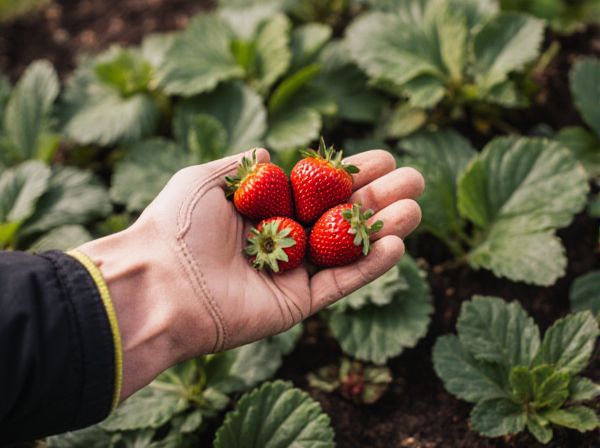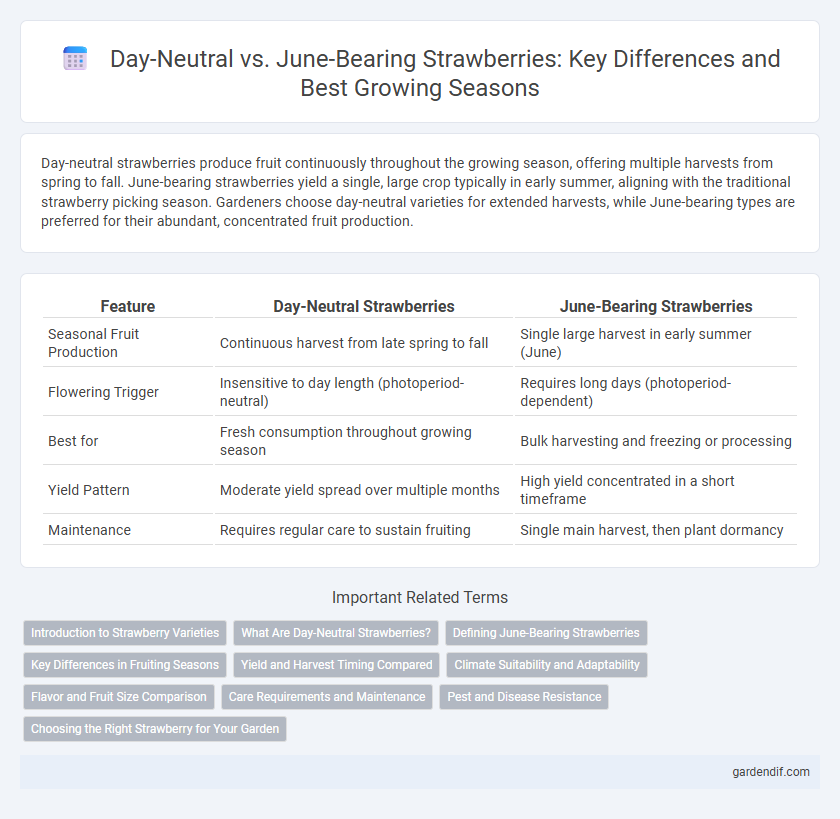
Day-neutral strawberries vs June-bearing strawberries Illustration
Day-neutral strawberries produce fruit continuously throughout the growing season, offering multiple harvests from spring to fall. June-bearing strawberries yield a single, large crop typically in early summer, aligning with the traditional strawberry picking season. Gardeners choose day-neutral varieties for extended harvests, while June-bearing types are preferred for their abundant, concentrated fruit production.
Table of Comparison
| Feature | Day-Neutral Strawberries | June-Bearing Strawberries |
|---|---|---|
| Seasonal Fruit Production | Continuous harvest from late spring to fall | Single large harvest in early summer (June) |
| Flowering Trigger | Insensitive to day length (photoperiod-neutral) | Requires long days (photoperiod-dependent) |
| Best for | Fresh consumption throughout growing season | Bulk harvesting and freezing or processing |
| Yield Pattern | Moderate yield spread over multiple months | High yield concentrated in a short timeframe |
| Maintenance | Requires regular care to sustain fruiting | Single main harvest, then plant dormancy |
Introduction to Strawberry Varieties
Day-neutral strawberries produce fruit continuously from late spring through fall, offering an extended harvest season ideal for home gardeners and commercial growers seeking consistent yield. June-bearing strawberries, known for their single, large crop in late spring or early summer, deliver high yields but limited harvest duration. Understanding these key differences in fruiting patterns helps optimize planting schedules and maximize strawberry production throughout varying seasons.
What Are Day-Neutral Strawberries?
Day-neutral strawberries produce fruit throughout the growing season, regardless of day length, making them ideal for continuous harvest from spring to fall. Unlike June-bearing strawberries, which yield a single large crop in early summer, day-neutral varieties provide multiple smaller harvests, enhancing productivity and availability. These strawberries thrive in temperatures between 35degF and 85degF, offering flexibility for growers in diverse climates.
Defining June-Bearing Strawberries
June-bearing strawberries produce a single, concentrated harvest typically lasting two to three weeks in late spring to early summer. These varieties develop flower buds during the short-day period of late summer and enter dormancy in winter, making them highly seasonal. They yield larger berries and higher total fruit production compared to day-neutral strawberries, which fruit continuously throughout the growing season.
Key Differences in Fruiting Seasons
Day-neutral strawberries produce fruit continuously from spring through fall, roughly May to October, regardless of day length. June-bearing strawberries have a concentrated fruiting period in late spring to early summer, usually lasting two to three weeks in June. This distinction in fruiting seasons affects harvest duration and crop planning for growers.
Yield and Harvest Timing Compared
Day-neutral strawberries produce consistent yields throughout the growing season, typically from late spring to fall, providing a steady supply of fruit. June-bearing strawberries have a concentrated harvest period, yielding a larger crop mainly in late spring to early summer. Choosing between these depends on whether continuous harvest or a single, abundant crop fits the grower's needs.
Climate Suitability and Adaptability
Day-neutral strawberries thrive in mild climates with consistent temperatures ranging from 60degF to 80degF, allowing continuous fruit production throughout the growing season. June-bearing strawberries are best suited for cooler climates with distinct seasonal changes, typically producing a single large crop in late spring or early summer. The adaptability of day-neutral varieties to warmer and fluctuating conditions makes them ideal for regions with extended growing seasons, whereas June-bearing types excel in areas with pronounced winter chilling requirements.
Flavor and Fruit Size Comparison
Day-neutral strawberries produce fruit continuously throughout the growing season, resulting in consistently sweet and flavorful berries with smaller to medium size. June-bearing strawberries yield a single, large crop annually, offering larger berries with a richer, concentrated flavor profile ideal for fresh eating or preserves. Flavor intensity in June-bearers often surpasses that of day-neutral varieties, while day-neutral types provide extended harvest periods with moderate fruit size.
Care Requirements and Maintenance
Day-neutral strawberries require consistent watering and regular fertilization throughout the growing season to support continuous fruit production, with mulch recommended to retain soil moisture and suppress weeds. June-bearing strawberries demand focused care during the spring fruiting period, including timely removal of runners and proper fertilization to enhance berry size and yield. Both varieties benefit from disease monitoring and appropriate pest management to ensure healthy plants and optimal harvests.
Pest and Disease Resistance
Day-neutral strawberries exhibit moderate resistance to common pests such as aphids and spider mites, with a better tolerance to powdery mildew compared to June-bearing varieties. June-bearing strawberries, while producing fruit primarily in early summer, tend to be more susceptible to gray mold and root rot but often respond well to preventive fungicide applications. Both types benefit from integrated pest management practices to maintain plant health and optimize yields throughout their respective fruiting seasons.
Choosing the Right Strawberry for Your Garden
Day-neutral strawberries produce fruit continuously from spring through fall, making them ideal for gardeners seeking a steady harvest over multiple seasons. June-bearing strawberries yield a single, large crop early in summer, offering higher yields during a concentrated period, perfect for those focused on bulk harvesting. Selecting the right variety depends on your climate, space, and desired harvest schedule to maximize productivity and fruit quality.
Day-neutral strawberries vs June-bearing strawberries Infographic

 gardendif.com
gardendif.com